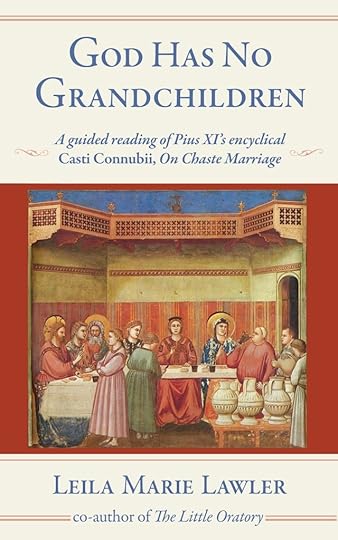Leila Marie Lawler's Blog, page 46
September 24, 2016
{bits & pieces}
The weekly “little of this, little of that” feature here at Like Mother, Like Daughter!
The mills of decoration grind slowly.
Today I will try to make sense of these (and other) shelves in my new laundry room/lavatory, and that clutter.
Wish me luck.

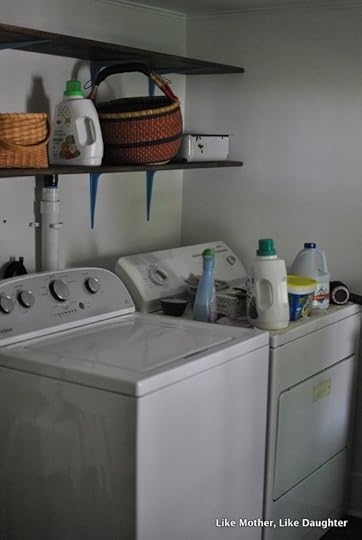
Our links today:
Timothy P. O’Malley, director of the Notre Dame Center for Liturgy, writes a curiously compelling little piece about why chant in worship is good for children.
Fr. Schall, musing on libraries.
The most sobering, yet consoling, passage about books, and hence libraries that contain and classify them, is that found at the end of John’s Gospel: “There are also many other things that Jesus did, but if these were to be described individually, I do not think the whole world would contain the books that would be written.”
Last time, I posted (without commentary) a piece by Peter Hitchens on the new, non-Cold War Russia he thinks he detects. Here is a rebuttal: Frontline Realism.
You know me, Mrs. You-should-read-a-papal-document: I’m going to post about sex education shortly. You might start reading this excellent document to get ready.
I haven’t seen Inside Out, though I want to soon. But this critique is too good to pass over or even leave for later. It’s just a good expression of what the mind is, against the materialist premise that what’s inside us are merely a collection of emotions or, ultimately, random atoms colliding.
A fun and rollicking look at what makes English a uniquely peculiar language.
Butter vs. shortening in your pie crust making, via King Arthur Flour. A nice little demonstration.
From the archives:
My own little tutorial on pie crusts. I say, just find the lard (to add to your butter). Shortening makes my stomach hurt.
Here’s a random post (I’ve been going through my posts) that probably will never make it out of the archives, but is sort of fun and has those two little observations of mine about getting things done.
Today is the feast of Our Lady of Ransom.
~We’d like to be clear that, when we direct you to a site via one of our links, we’re not necessarily endorsing the whole site, but rather just referring you to the individual post in question (unless we state otherwise).~
Follow us on Twitter.
Like us on Facebook.
Auntie Leila’s Pinterest.
Rosie’s Pinterest.
Sukie’s Pinterest.
Deirdre’s Pinterest.
Habou’s Pinterest.
Bridget’s Pinterest.
Habou’s Blog: Corner Art Studio.
Auntie Leila’s Ravelry.
Auntie Leila’s Instagram.
Rosie’s Instagram.
Sukie’s Instagram.
Deirdre’s Instagram.
Bridget’s Instagram.
The post {bits & pieces} appeared first on Like Mother Like Daughter.
September 19, 2016
Mrs. Piggle-Wiggle: Read this, not that
Do you know this “eat this, not that” series of books? The idea is to help you make good choices in food and drink to avoid hidden calories that will tank your health. Well, Rosie had the thought that we could do something similar with books for the Library Project*.
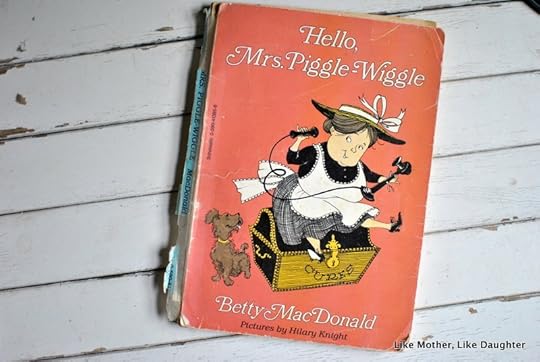
Our well-worn copy of Hello, Mrs. Piggle-Wiggle! (All the book links in this post are Amazon affiliate links and give us a little pocket change.)
No one expects me to like a new, updated version of mostly anything, but I’m trying to be balanced…
However, I’m probably failing.
There’s a new Mrs. Piggle-Wiggle, I have recently found out (and another one due next year).
In the new Mrs. Piggle-Wiggle, the drawings are really nice, which is saying something, because Hilary Knight’s whimsical imagination made so many books come alive.
But after that, I’m not sure why we don’t just stick with the old ones. If people would like to update old things, why don’t they just try their hand at invention? Plenty of great new things use the old ones as a starting point, it’s quite legitimate. In fact, you’d be hard-pressed to come up with something completely new. One wonders about the marketing angle…
The new Mrs. Piggle-Wiggle tries to have the same light-heartedness as the old, but right from the beginning it’s heavy going, with the first “problem” not even appearing until chapter 3. I don’t know how you are supposed to keep the kids’ attention through all that back-story. The original dives right in with very little explanation, allowing us to figure things out as we go.
How is the old Mrs. Piggle-Wiggle not perfect?
“Too 50s” — which means, everyone has parents who are married to each other and Dad goes to work while mom stays home.
Well, there are worse things than that! No one reads Aesop’s fables and complains that it’s all about animals! It is what it is. And dare I say, how else will children find out the secret if we rewrite all the stories to reflect the new “normal”? As a child with divorced parents, I was grateful for stories that depicted stability.
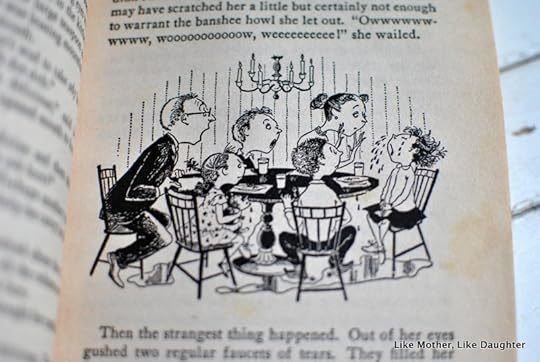
And as to the enlightenment of our time: The truth is, even now when parents are oh so liberated and tasks fall on everyone equally because we have decreed it to be so, men still have to think about work and women still fret over household matters… and, often, work as well.** It’s just all more stressful now because no one dares admit it.
**A truth borne out by all studies everywhere. Nothing is more common than a father who is distracted by his job, or a mom who’s focused on the minutiae of the kids’ behavior. We just don’t have a sense of humor about it nowadays. (How’s that for a statement!)
Casting characters according to type is a time-honored practice that yields much comedy. It would be sad to think that we have to do away with the healing powers of laughter, but I fear that many a smile has been sacrificed at the altar of “realism.”
It’s hard to believe, dear reader, given the sorry state of children’s literature today, but these books are not how-tos. They are hilarious stories! I still chuckle when I remember “I thought you said, ‘She fell in the toaster and was burnt up dead!'” from probably the best chapter ever, The I Thought You Saiders Cure — and when I remember all the times I laughed with my kids over these books.
They are rollicking good fun, with a healthy airing of human nature. There aren’t ponderous morals for children (although there is wisdom for parents, which is why they keep us interested as we read!) If only our real parents would let us dig holes wherever we wanted in the yard! (To be fair, the new version retains this attractive feature of Mrs. Piggle-Wiggle’s house. I’m not saying don’t read it. I guess.)
And you know what, it might not be a bad idea to be reminded of how futile it is to “crowd-source” child-care advice (think “online forums” or “facebook mom’s groups”!) — just call Mrs. Piggle-Wiggle instead!
Other funny children’s chapter books to read aloud:
The Children of Noisy Village by Astrid Lindgren (I wrote more about this here.)
B is for Betsy and Betsy and Billy by Carolyn Haywood (and who thought any of these “updated” covers were in any way attractive? I ask you! Try to find an old copy!)
The Henry and Ribsy series by Beverly Cleary (her books are usually pretty funny, to a kid at least)
Penrod by Booth Tarkington (I wrote more about this here)
Amelia Bedelia by Peggy Parish (for very young chapter-book readers who are trying to figure out why you say things like “dress” the chicken — if you do ever roast a whole chicken!)
What funny books do you love to read out loud with your children?
*What is the Like Mother, Like Daughter Library Project?
The post Mrs. Piggle-Wiggle: Read this, not that appeared first on Like Mother Like Daughter.
September 17, 2016
{bits & pieces}
The weekly “little of this, little of that” feature here at Like Mother, Like Daughter!
Recently we got the exciting upgrade from crib to Big Girl Bed.

Yesterday I took the kiddos to the nursing home near us, just to provide the residents with some company. I got a tip from a local parish newsletter that this is a good volunteer opportunity for moms of children; lots of other things we’d like to help out with are not doable with kids in tow, but visiting the elderly is not only possible with children, but (as I’ve been learning) so much better with children! I keep saying that I have never made people so happy with so little effort: the old folks are just overjoyed to see toddlers, and my kids get a lot out of it too. (When we were younger, my sisters and I would sometimes visit the elderly to do singing or Irish Step Dancing for them. I did this a little bit with college friends as well.)
It certainly helps me out that we have a nursing home literally three blocks from us.
Two visiting tips that I’ve recently learned:
Balloons. If you have a child and the child has a balloon or there is a balloon drifting around in the room, all the rest will sort itself out. The kid will play with the balloon or can pass it back and forth to an elderly person… whatever happens, all parties will be delighted.
Name tags. I think next time I will try having a name tag…
This is me meeting someone who is hard of hearing:
“What’s your name, dear?”
“Deirdre.”
“What?”
“DEIRDRE.”
“Georgia?” (I get that a lot.)
[fast forward to:]
“You can call me DEE!”
Yesterday was a special day, as it included this exchange:
“Tell me your name?”
“DEIRDRE”
“Shear-shan? what?”
“DEAR-RAH! DEER-DRUH.”
“…Beer-Cup?”
Don’t think I can top that one.
Anyway, I didn’t have any photos of the nursing home. But I did have a photo of the Big Girl Bed. So there you go.
This week’s links!
A-mazing photos of the interiors of churches with a twist: a vertical panoramic view. It’s a little bit dizzying and a lotta bit awesome.
If you are someone who enjoys listening to Catholic content (podcasts and all that… something I’ve never gotten around to), you might be interested in a heads up about Catholicast. I don’t know a whole lot about it, but have heard this from a friend whose parents are the ones responsible for forming the collection:
“We recorded priests, nuns, monks, psychologists, married couples, great evangelists, bishops, archbishops, Metropolitans, and even a Rabbi. :-)…
After years of only having all these treasures available only via CD, my older brother, Mark, and my parents are in the midst of putting all the talks that we have recorded, online, to make them available for the benefit of all for a monthly subscription fee.”
A new service is on the horizon for women in New England (and it happens to be here in Manchester): Catholic Medical Center is preparing to open a new Women’s Wellness Center for OBGYN care. Right now, the area doesn’t have any major place for women to turn if they want reproductive health care that is Catholic, but this place will be 100% above-board, including offering NaPro Technology to treat infertility.
If you’re around here and you’re interested, call them to get on the patient registration wait list! They are hoping to have people signing up right away so that the powers that be know that this care is in demand.
We’ve posted this before, but Auntie Leila thought it would be worth revisiting, since we’ve been talking about the whole parental supervision/children’s play topic: Not Duffers, Won’t Drown. It’s also relevant because there is a movie coming out! I haven’t read the book, so I’ll have to get on that… the movie certainly looks exciting.
Did you catch my mom’s update yesterday about doings around here and, in particular, her upcoming eBook God Has No Grandchildren? (Isn’t it such a good title?)
OK, someone talk to me about Magic Custard Cake. I saw a series of articles about how amazing this kind of cake is and I’m certainly interested to try it!
Liturgical Year:
Today we honor St. Robert Bellarmine
From the Archives:
Library Project: Salt & Pepper and the Wonder Clock
~We’d like to be clear that, when we direct you to a site via one of our links, we’re not necessarily endorsing the whole site, but rather just referring you to the individual post in question (unless we state otherwise).~
Follow us on Twitter.
Like us on Facebook.
Auntie Leila’s Pinterest.
Rosie’s Pinterest.
Sukie’s Pinterest.
Deirdre’s Pinterest.
Habou’s Pinterest.
Bridget’s Pinterest.
Habou’s Blog: Corner Art Studio.
Auntie Leila’s Ravelry.
Auntie Leila’s Instagram.
Rosie’s Instagram.
Sukie’s Instagram.
Deirdre’s Instagram.
Bridget’s Instagram.
Save
Save
Save
The post {bits & pieces} appeared first on Like Mother Like Daughter.
September 16, 2016
Finding a rhythm.
I’m not super great about hyping my writing, and here I am really going to have trouble, I think, because, well, study guide, encyclical, Latin, chastity, guided reading, papal document — do these seem like key words destined for search engine optimization or New York Times bestsellerdom?
I think not.
But, here goes:
I’m really excited to tell you that very shortly, you will be able to buy (for a hilariously low price) my Casti Connubii (On Chaste Marriage) guided reading on Kindle! I know! How thrilling is that! (Isn’t the cover lovely though? Deirdre’s husband John designed it for me.)
But seriously, reading this deep work has changed lives, as only an encounter with the truth can.
More on that later…
I’m finalizing the upload now. This short book will be the posts that you can find here on the blog, but edited and put in order so that you and your friends can easily access the whole thing for a study group/book club. For instance, it’s perfect for couples to read in your St. Greg’s Pocket! Or just the men! (I’d love to see that — men reading this document… could it happen?)
So stand by!
This is just one of the things I’ve been working on, all the while trying to see what the new normal will be for this online journal of ours. We love having the blog to check in with you…
Finding rhythm is the key. Routine sometimes soothes, sometimes crushes. But when I think of rhythm, I realize that not only do I have to find some inner beat that fits my life, but it will be best if it’s connected to that outer beat of life as it moves on (and of course, with the heartbeat of the Church).
I’ve been writing — working on a big project and also trying to tie up ends of some smaller bits as well. It means I’m slower about coming here, I realize. And Rosie is getting settled in her new digs (by the ocean again — not as close as Camp Pendleton, but close! hopefully she’ll show us soon!), finding her groove. Suki is chasing two active babies and doing a bazillion things. And Deirdre has been working on getting her site up and running along with a bazillion other things. You know how it goes.
Don’t worry, we’re here. The rhythm seems like it will be a bit different, but we’ll be here.
The post Finding a rhythm. appeared first on Like Mother Like Daughter.
September 14, 2016
Ordinary beauty.
If you’ve ever heard a talk given by me in the past year or two, you’ve heard me dwell for a bit on a lovely observation from Roger Scruton on beauty. He points out that there are two kinds of beauty:
“The individual, expressive and revealing gesture, and ordinary harmony and fittingness. In everyday life it is the second kind of beauty that is important, and it is exemplified in home building, gardening and the design of squares, houses and streets. It is important because it expresses and amplifies the human desire for settlement, for an environment in which things fit together and people too.
“It is an instrument of peace.”
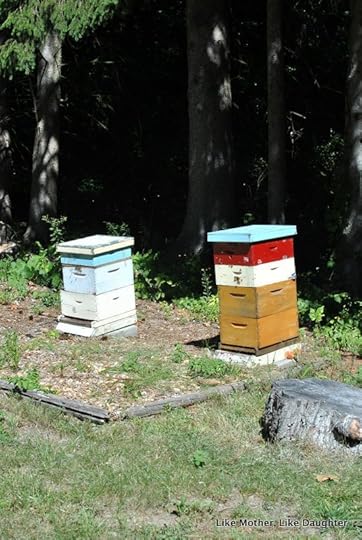

Summer is winding down.
The bees are working hard, but there won’t be a huge harvest this year. It was too dry. The grass in my backyard has recovered somewhat; in the front, it’s still pretty stressed. However, it was never impressive, even on its best days.
I see all the weeds I haven’t pulled. I see them clearly.
I see my plans, and how I didn’t get to many of them.



The garden is what it is. I dream in June, and I pick what I can in September — plenty of tomatoes this year, kale always, and raspberries! Which is just a treat.


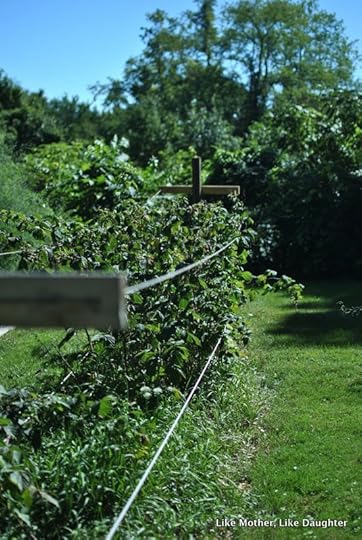
Inside, there are shelves to put up in the laundry room. We could have done that job over Labor Day weekend, but we went to friends’ daughter’s wedding and took advantage of the proximity to children and grandchildren to make the rounds. And certainly, that is all good!
I’m looking forward to these dark shelves against the white walls, held up by perhaps overly bright blue brackets.
And I need to make some quilts, but I’m not feeling it just now. Hopefully I will soon — maybe when the cooler weather settles in for real and the tomatoes are safely inside.
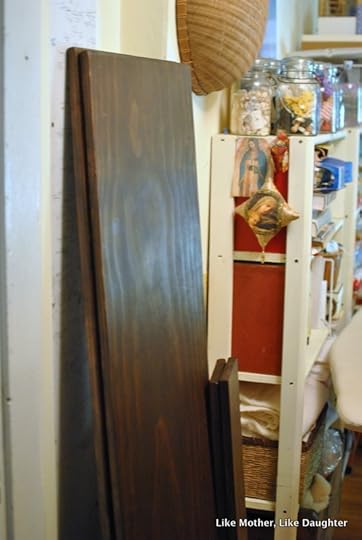

Scruton speaks of how ordinary beauty is imperfect, unlike the perfection of the grand gesture. But it reconciles us to our own imperfection, while allowing us to remember that there is perfection.
It gives us a home in the world.
I believe that these words resonate particularly with the mother and the father of the family, however large or small it may be. If we serenely pursue this ordinary beauty in everyday things and relationships, we build our home. This beauty gives us settlement, and it gives others settlement as well. It gives them a glimpse of what they can have, themselves, without the anxiety of thinking they must somehow be perfect; paradoxically, it’s that very home-likeness, the imperfection, that most reminds them, and us, of Perfection.
The post Ordinary beauty. appeared first on Like Mother Like Daughter.
September 10, 2016
{bits & pieces}
The weekly “little of this, little of that” feature here at Like Mother, Like Daughter.

So I’ve sort of ruined my life by becoming an expert at making tortillas. I more or less use this King Arthur recipe (I probably end up using more flour, and unless I have lard handy, I use my stored bacon fat). It’s not super hard, mind. But it does take a bit of time and concentration, unlike ripping open a package of store-bought.
It’s terrible. It’s a kind of terrible obsession where you are forced to roll out and individually cook up each tortilla.
You have to, because they are just that good and that different. They are super amazing. They are devastating. How will I recover? Is every meal to be a monstrous chore??
But recently, I found this recipe for homemade sourdough tortillas that you don’t have to roll out. You make them more like pancakes or crepes.
So what I want to know is, have you tried both ways? Can it be that not rolling could be a tad more efficient but just as good? Can you advise?
This week’s links:
A delightful interview with Fr. Schall.
“One advantage of a liberal education is that, through novels, poems, histories, and biographies, it takes us through the human condition before we ourselves are much exposed to it. This vicarious learning is what education is supposed to be, not merely a preparation for a job, which we can usually learn quickly. Liberal education is a preparation for life about which we need to know much, if we can, before and during the time we live it ourselves.”
When we were in Paris, we saw a boatload of armor at Les Invalides. Many, many boatloads. It’s hard to believe that this was a viable way to protect oneself. This video helps figure it out:
Peter Hitchens on Russia: The Cold War is Over.
The importance of remembering the horrors of the Soviet Union: The House is on Fire! (Everyone should read Alexander Solzhenitsyn’s Gulag Archipelago — I’m sure you can find a used hardcover copy. Any senior in high school can read it, though it’s quite a tome, and should. For freshmen, One Day in the Life of Ivan Denisovich is a good introduction to the themes of the articles and the Gulag — an amazing novel, a work of art, not long, that plunges you right into the depths of the totalitarian nightmare.)
A young man who makes musical instruments. “I’m man creating something, something beautiful.”
From the archives:
I give you some tips for thrifting!
A really foolproof, really delicious chocolate cake that everyone wants for their birthday!
Happy feast of St. Nicholas of Tolentino!
~We’d like to be clear that, when we direct you to a site via one of our links, we’re not necessarily endorsing the whole site, but rather just referring you to the individual post in question (unless we state otherwise).~
Follow us on Twitter.
Like us on Facebook.
Auntie Leila’s Pinterest.
Rosie’s Pinterest.
Sukie’s Pinterest.
Deirdre’s Pinterest.
Habou’s Pinterest.
Bridget’s Pinterest.
Habou’s Blog: Corner Art Studio.
Auntie Leila’s Ravelry.
Auntie Leila’s Instagram.
Rosie’s Instagram.
Sukie’s Instagram.
Deirdre’s Instagram. ~ she just started and posts her beautiful Pysanky work!
Bridget’s Instagram.
The post {bits & pieces} appeared first on Like Mother Like Daughter.
September 9, 2016
The body in worship ~ The Spirit of the Liturgy, A Book Club

{Book Club: The Spirit of the Liturgy}
I hope you will read along in this book club (or just read my posts, that’s okay): Joseph Ratzinger’s The Spirit of the Liturgy.
(When you buy something via our Amazon affiliate link, a little cash rolls our way… just a little. Thanks!)
I’ll post on Fridays, although for this longer book, perhaps not every Friday. I’ll give you your homework, I’ll talk about what we read, we’ll discuss in the comments. Even if you read later, the comments will still be open.
Previously:
Introduction to the reading: Joseph Ratzinger’s The Spirit of the Liturgy: A Book Club for Easter and Beyond
Nature or history in worship? Or both?
The Relationship of the Liturgy to Time and Space: preliminary questions
The Reservation of the Blessed Sacrament
Unspontaneity, The Essence of Rite
Homework: We’re at the end! Rather than homework, a resolution, perhaps: Think and pray about how these amazing insights can be implemented in your life and shared with others. We need a renewal in how our faith is expressed, because we are made for worship! What are the two great commandments?
Jesus said unto him, Thou shalt love the Lord thy God with all thy heart, and with all thy soul, and with all thy mind. This is the first and great commandment. And the second is like unto it, Thou shalt love thy neighbour as thyself. On these two commandments hang all the law and the prophets. (Matthew 22:37-40)
Chapter Two, Part IV: The Body and the Liturgy
The coming of Christ as true God and true Man opened up a new revelation in the meaning of worship. The whole theme of Joseph Ratzinger’s The Spirit of the Liturgy is to demonstrate how worship goes from “representative” to “actual.”
There is only one way for this to happen, that God Himself must come to be the sacrifice, and to unite himself to us so that we too are sacrifice — where only a Divine sacrifice is fitting. He became man that we might become divine.
Perhaps you’ve heard of “active participation” or even “actual participation” in worship. Those terms have become almost weaponized; certainly they are misunderstood. What I love about this chapter is the engagement with every detail of participation. We maybe expected (especially from an intellect of this stature) something lofty and abstract. Instead, we got a minute inquiry (and examination of conscience) into every posture and gesture and substance in its relation to the liturgy.
For we have a body.
We are embodied.
Jesus himself had a body. Among other things, the particularity of the account of his infancy is meant to convince us of the intentionality of his body. Any other, rather more sloppy, deity would have had Jesus emerge from the Jordan, say, as a strong young man. In some ways, more convincing if you are looking to be impressed. But at least once a year we are forced to contemplate our God as a newborn, with all his humanity very much in evidence. (Think about the medieval propensity to show his little infant genitals. He. was. a. man. Think of how his little body is depicted on a slab of marble: he is God, sacrificed for us.)
The burnt offerings, the calves and sheep of ancient worship, are gone. God acted in time, and now we respond. We take part in the action — actual participation.
There is only one action, which is at the same time his and ours — ours because we have become “one body and one spirit” with him. The uniqueness of the Eucharistic liturgy lies precisely in the fact that God himself is acting and that we are drawn into that action of God. Everything else is, therefore, secondary… Doing really must stop when we come to the heart of the matter…
… Anyone who grasps this will easily see that it is not now a matter of looking at or toward the priest, but of looking together toward the Lord and going out to meet him. (P. 174)
In this passage, Ratzinger is trying mightily to lift us out of the trap of theatricality in worship. Instead of “acting like” we must learn to “act.” Squint your eyes at what you do in church and see if it passes this test.
And we act, of necessity, with our body, which is a temple! “In service for the transformation of the world…” (P. 175)
So our gestures must be trained.
We must learn what the gestures of liturgy are and how to make them. We must. Only with ritual (unspontaneous, formal order, received as a gift from Scripture and history) will we be able to internalize the external meaning of worship.
We are going to take a quick tour of the body, a “shorter” Ratzinger, with stops along the way to bring out the most important points. Do, do, do read this chapter if you don’t read any other. It will be of immeasurable help in teaching the children (and learning, ourselves) to pray.
The sign of the cross.
Do you need material for your prayer? Take this one section with you the next time you sit down to have a conversation with God. Make the sign of the cross and then read this amazing passage, an entire catechesis! about how fundamental and meaningful this simple gesture truly is.
It is a seal, “visible and public.” A confession of faith, in every article of faith: for the one who is crucified on the cross is the one who became Incarnate and whose Resurrection redeems. It protects, “a shield that will guard us in all the distress of daily life.” It signifies the Trinity. It reminds us of our baptism, when we died with Christ into rebirth, and “he has a name.”
“In the sign of the Cross… the whole essence of Christianity is summed up.” Yet, the roots of this sign are in Judaism, as “a widespread sacred sign… of faith in the God of Israel.”
It was also found in Greek culture in “the remarkable idea of a cross inscribed upon the cosmos” as we read in Plato’s Timaeus. The stars themselves proclaim the Cross, “the greatest symbol of the lordship of the Logos, without which nothing in creation holds together…. The Cross of Golgotha is foreshadowed in the structure of the universe itself.”
Once again we find the theme: “History and cosmos belong together.” This faith is not inside our heads only. It exists.
Do not miss the moving ending of this section, in which Cardinal Ratzinger remembers the sign of the Cross his parents made on his forehead when he was young, “… like an escort… made visible the prayer of our parents… a challenge… not to go outside the sphere of this blessing… a perfect expression of the common priesthood of the baptized.”
Posture and Gesture.
Kneeling. To kneel in worship is utterly Scriptural, and this whole chapter is a long excursion into Biblical examples. It “does not come from any culture” but from “knowledge of God.” According to the Desert Fathers, the Devil has no knees! The word for “worship” and for “kneeling” are the same in key passages of Scripture; only the evil one cannot bend the knee.
Jesus himself prayed on his knees at that moment when he is allowing us to see that he unites his will to the Father’s.
Like Prostration (and later in the chapter, bowing and striking the breast), kneeling expresses incapacity, humility, supplication.
The bodily gesture itself is the bearer of the spiritual meaning, which is precisely that of worship. Without the worship, the bodily gesture would be meaningless, while the spiritual act must of its very nature, because of the psychosomatic unity of man, express itself in the bodily gesture…
… when someone tries to take worship back into the purely spiritual realm and refuses to give it embodied form, the act of worship evaporates, for what is purely spiritual is inappropriate to the nature of man. (P. 190-191)
Standing and sitting. These postures are appropriate when a person is listening and reflecting. Standing expresses readiness to go, which, in addition to respect, is why Catholics always stand at the Gospel reading.
Dancing.
It is totally absurd to try to make the liturgy “attractive” by introducing dancing pantomimes”… which frequently… end with applause. Wherever applause breaks out in the liturgy because of some human achievement, it is a sure sign that the essence of the liturgy has totally disappeared and been replaced by a kind of religious entertainment. (P. 198)
I wish I could repeat that quote slowly, with attention to every phrase!
(As an admittedly not very important member of an excellent choir, it makes me die inside when the celebrant calls for applause “for the beautiful music.” Not one person in the choir sings for applause! How cringe-making! How terrible to think that we want to be thanked or recognized! Stop!)
Dance brings up the question of “inculturation” which Ratzinger will return to. But noteworthy is the immediate consideration that local customs are by definition less important than what unites. Will they actually divide? Yet, so often these customs, if truly from the heart of the people, are actually quite fitting in the celebration that occurs after the liturgy, during the celebration that arises from it.
The main worry about inculturation is precisely whether it expresses the culture and has arisen organically from it, or whether it’s imposed by “professionals” (as Ratzinger so rightly points out in the case of dance, and I would add, most pointedly in “folk” music). This imposition becomes an insult!
Authentic cultural expression unfolds and “leads to artistic work that interprets the world anew in the light of God.” It is “the inner opening up of a man to his possibilities.” (P. 201)
Popular piety is the soil without which the liturgy cannot thrive. Unfortunately… it has frequently been held in contempt…. Tried and tested elements of popular piety may pass over, then, into liturgical celebration, without officious and hasty fabrication, by a patient process of lengthy growth. (P. 202)
The human voice.
Among many beautiful points is the discussion of that long-neglected and rare gift, silence.
… silence cannot be simply “made”, organized as if it were one activity among many. It is not accident that… people are seeking techniques of meditation, a spirituality for emptying the mind. One of man’s deepest needs is… manifestly not being met in our present form of the liturgy…
… The Consecration [in the liturgy, when the bread and wine are changed into the body and blood of Christ] is the moment of God’s great actio in the world for us. It draws our eyes and hearts on high. For a moment the world is silent, everything is silent, and in that silence we touch the eternal — for one beat of the heart we step out of time into God’s being-with-us. (P. 212)
Vestments.
Vestments in liturgy have to do with “putting on Christ” and being made new. In Scripture we read, in the story of the Prodigal Son, that “the father gives this instruction: “Bring quickly the best robe… ” (Luke 15:22)… in reading the account… the Fathers heard the account of Adam’s fall, the fall of man (cf. Gen 2:7), and interpreted Jesus’ parable as a message about the return home and reconciliation of mankind as a whole.”
Matter.
This section goes beyond the body to actual stuff out there in the world. Water, wine, bread, oil. Water is universal to all, but the other three? Are they not imposed by the Mediterranean culture onto the others?
This is the same issue that we encountered when we were discussing the inversion of the cosmic symbolism of the seasons in the Southern Hemisphere. The answer we gave there applies again here: in the interplay of culture and history, history has priority. God has acted in history and, through history, given the gifts of the earth their significance… Incarnation does not mean doing as we please. On the contrary it binds us to the history of a particular time. (P. 224)
Does this binding limit us? No! It frees us! We “emerge from the… vagueness of mythology.”
It is with this particular face, with this particular human form, that Christ comes to us, and precisely does he make us brethren beyond all boundaries. Precisely thus do we recognize him: “it is the Lord” (Jn. 21:7). (P. 224)
What a fitting way to end the book! I loved it! Did you?
Questions? Comments? I’d love to hear from you!
(Emphases added in quotes are mine.)
Click here to see our previous discussion of Romano Guardini’s The Spirit of the Liturgy, which you can read free, online. You can also purchase it here, although be warned, this edition does not have the footnotes, which stinks .
.
The post The body in worship ~ The Spirit of the Liturgy, A Book Club appeared first on Like Mother Like Daughter.
September 3, 2016
A rant on modern motherhood along with your {bits & pieces}
The weekly “little of this, little of that” feature here at Like Mother, Like Daughter.
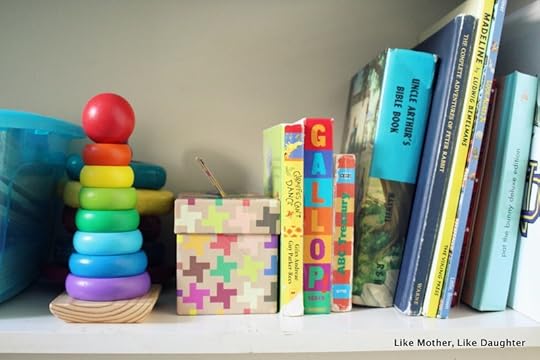
OK, I actually have a lot to say about this article, so it’s going to be my headliner: How Getting Rid of Stuff Saved my Motherhood — normally I would say that this kind of title is irritatingly clickbait-y, and perhaps not even use it here. But, actually, I think that it may not be an exaggeration in this case.A few things stand out to me here.For one thing, this woman was told by other moms that her miserable home life was normal and that she’d “get through it.” How many of us are told that we’ll “get through it,” that motherhood is something we just have to “get through?” When I look around me at the women who are mothering by today’s standards and feeling pressure to have it all, I absolutely see women who are “getting through it,” feeling dragged through their day-to-day activities, feeling stressed out, feeling left behind, and consoled simply by the thought that “this is just a phase.” “Suffer through these childhood years and then you can go back to a career where you’ll be thanked and at least feel in control of a few parts of your day… or be able to drink coffee alone, if nothing else.”It is this mindset and way of life that makes having more than two children simply too difficult. If you’re going to “get through it,” there has to be an end date, and it can’t be more than a decade away. This exhausting, draining, stressful phase had better wrap up while you still have a little life left to live. Honestly, when I look around at the oppressive norms and the meager resources most women are working with, I get it. I don’t think I could handle even considering the addition of a third child, if those were the cards in my hand.
So I commend this lady for refusing to settle for that answer. Not only is there more to mothering little kids than “getting through it,” but in fact this season and every other season of family life can be a time of joy and flourishing. But: we have to reclaim traditional ways in order to learn how (in her case, she taps into the old-school understanding that children don’t need many toys).
For another thing, and very obviously, her story is a great reminder of how material things can bring us down. We, as mothers, can be vulnerable to marketers who want to peddle us more and more stuff with the tempting line that each new “thing” is going to make our job easier. A new toy will occupy the kids and we’ll be left alone, right? We need retail therapy when we’re feeling down so that we can be reminded that we’re real people too, right?
We accept the stereotype that, once a baby comes into your life, your house has to be not just sprinkled, but coated with toys, swings, endless accoutrements that are beeping and singing and tripping you up… This is supposed to be obligatory.
And yet, the stuff in this woman’s life was actually making her depressed. It was thwarting her children’s play! Our Faith tells us that we should place our treasure in Heaven and not in material things — are we surprised to learn that allowing too many things in to our life can bring us down?
Finally, this study she mentions from UCLA: there you have it, ladies. We care about our homes. Even if we tell our minds that we don’t care, our bodies will remind us that we do. When an untidy house raises our stress hormone levels and we feel that we’re failing our families if we’re too cluttered, it’s time to assert, once again, the value and status of the homemaker and the housekeeping. Whatever the feminists tell us, this does matter to us (not so much to the men, eh? notice that?) and we should do the things that make us and our families happy and help us to be better women and mothers.
The author mentions that she had her fourth baby after getting this housekeeping thing under control. I have to ask myself how much her clutter-free, happy state played into the event of welcoming a new life into the family. How many women are out there, thinking that once upon a time they wanted more kids, but now that they’re in the thick of it, “getting through it,” they realize that there’s no way; they’re simply not up for it?
So yes, in a sense, this de-cluttering is the kind of move that saves motherhood.
I only go on about it to remind you, as this article has reminded me, what LMLD is all about: rediscovering the practical ways and methods, the habits, the old-fashioned wisdom, the meal plans, the laundry strategies, the educational know-how… the collective memory… that makes this life of ours not something to “get through,” but a honed skill, a source of contentment, a channel of grace, a joy.
More on parenting and children:
I have posted something along these lines before, but I for one never get tired of it. (Let the record show that I do not support children severing their fingers.) Should we Let Toddlers Play with Saws and Knives? from the WSJ.
Why do we Judge Parents for Putting Kids at Perceived – but Unreal – Risk? from NPR. From the article: “The people with presumably the most child care experience (mothers) actually expressed the most exaggerated overestimates of risk. I was genuinely surprised by that. But I guess that’s because I was expecting people to be rational, and people are just not rational about this subject.” (NB: you would probably guess as much, but we do not endorse the viewpoint represented here that fathers don’t make a unique contribution by working and mothers by care-taking.)
The Screen Hoax from Time Magazine. I’ve always had a very bad feeling about the influx of expensive screen technology into every classroom, but now I’m feeling fired up about it. This article makes me think that parents should be forming coalitions to start pushing back against the system that is promoting this “pedagogy” (which is unsupported by research) at the expense of the taxpayer and, most importantly, at the expense of the child.
In the World of Science:
An astounding story of a man, Martin Couney, who changed medicine and creatively cared for preemies, saving thousands of lives… and was also a fraud.
For the star-gazers in your household: What Starlight Teaches us About Space (Pretty Much Everything)
Zeugma After the Flood. Recent excavations have unearthed amazing mosaics in Turkey.
Miscellany:
For big-picture considerations to help us think about what makes good policy, read Immigration and the Family by Fr. Jerry Pokorsky.
In Iceland, a hand-drawn map is as good as an address. So appealing, right? Auntie Leila thinks perhaps because of our desire to be known?
Looking for a reading list? Here is one compiled from C. S. Lewis’ An Experiment in Criticism. I’d say he’s probably a good source for a solid bibliography…
And if you’ll allow some self-promotion:
I’m finally joining Instagram in an effort to give a glance into my arts-and-craftsing “workshop.” If you’re on there, please follow me as I get started! I’m DaedalShop.
And don’t forget to follow the others, too — links are below, as usual!
In the liturgical year — It’s a big one for us today:
Today is the feast of St. Gregory the Great, the patron saint of the St. Greg’s Pockets!!
Not only do we women need the collective memory in order to be at peace and not just “getting through,” but we also need community! We need each other, other women, especially ones who are a bit further down the road than us and can help us along. And women who are just getting into the whole motherhood gig need us. Yes, much of it is hard, and that’s why we need other women who are there, in person, to be with us along the way and show us how or at least share in the difficulties. To try to do it alone is a disservice to ourselves and our families, and not helpful to other women and their children who could really use our help (once we’ve got a thing or two down).
So, if you’re not already benefiting from a Pocket, what are you waiting for? Is there one in your area? Check the list. Could you get one started? Maybe think about it today and say a prayer to St. Gregory!
If you have any particular questions or need specific encouragement, feel free to email us or comment here to ask! We want to help you and your families have this great community in your neighborhood!
Special note: Any ladies in Boston who could get a Pocket going? I know of at least one and I think maybe two women who are really struggling in that area to have any community to support their motherhood. If you are there, could you band together with a friend to get the FB group going and start a Pocket? If you know someone there, could you encourage her to do this? The need is real!
Happy Feast Day!
~We’d like to be clear that, when we direct you to a site via one of our links, we’re not necessarily endorsing the whole site, but rather just referring you to the individual post in question (unless we state otherwise).~
Follow us on Twitter.
Like us on Facebook.
Auntie Leila’s Pinterest.
Rosie’s Pinterest.
Sukie’s Pinterest.
Deirdre’s Pinterest.
Habou’s Pinterest.
Bridget’s Pinterest.
Habou’s Blog: Corner Art Studio.
Auntie Leila’s Ravelry.
Auntie Leila’s Instagram.
Rosie’s Instagram.
Sukie’s Instagram.
Deirdre’s Instagram.
Bridget’s Instagram.
Save
Save
The post A rant on modern motherhood along with your {bits & pieces} appeared first on Like Mother Like Daughter.
August 31, 2016
A little spray-paint tutorial, in which my methods are revealed.

We are slowly accomplishing this project of re-purposing rooms.The laundry is now on the second floor in the newly re-done bathroom, which is next to the other bathroom that was also re-done.
That leaves the place in the mudroom to be fixed up, where the washer and dryer were.
A friend suggested a bench, and it just so happened that Craigslist had the exact one I needed. This post is not about that, so I will give you this one sneak peek:
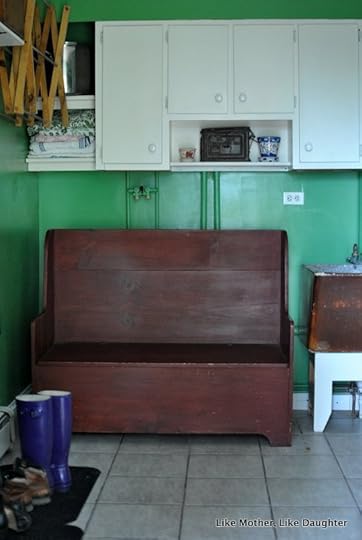
If you want to see how it was before, this post will remind you, and also give a more realistic view of the green, which for some reason looks weird here to me, which is no good because it is the best green ever.
Anyway, I am here to clear up mysteries about spray painting.
Painting in general is something that can be made very, very complicated. And if you are me, just dealing with brushes alone is enough to prevent me from painting things. So while yes, you can achieve the nice painted finish without the spray, I would like to offer some reasons to pay the premium (in money and in possible lung collapse but more on that below).
First, when the job is small, you are not going to save money on buying a container of paint. That’s because brushes are expensive (especially ones for non-latex paint, which this is). It’s true: per gallon, paint in spray cans is dear. However, your container of cost-effective enamel paint will be mostly wasted. I think we all know what happens to that two thirds of a can of paint… it dries out and you have to chuck it.
If you need to paint something big, by all means, go the brush route. But for little things, spraying is the way to go.
Second, I am brush-averse. I hate having to deal with a brush between coats (tip: wrap it in plastic wrap — don’t clean until the very end!). I hate the clean-up, no matter how long it is postponed — even for latex paint. I detest not knowing where to put a brush when I need to answer my phone. Spray painting eliminates all that.

So, as promised, here you have a view of how I do this job in my own super-professional way.
Basically, you want to have a surface of cardboard — not newspaper! Newspaper gets glued to any object being painted. Please, for the love of all that is doing a job with a minimum of fuss, don’t use newspaper.
If this object to be painted was a table or something more vertical, I would set up cardboard behind it as well, and probably prop the cardboard against my trash barrel.
You want it at a good height and in the light. This is my well known Garage of Death, which yes, has a vine growing into it at this moment (the Trumpet Vine of Voracious Activity). It’s a country garage, not a suburban one. That means, it’s the kind of which your four-year-old might exclaim, “Mama! Did you know that some people put CARS in their garage??”
Yes, honey, I’ve heard tell…
Well, my garage is a fine place to do this painting. You could also do it outside — I painted a crib out on the driveway.
Important tip #1:
Shake the can! The directions say to shake for a least a minute. You have no concept of how long a minute is when you are shaking! It’s an eternity. Watch a video on your phone so that you actually shake for that long. And shake whenever you pause your spraying.

Important tip #2:
You need to commit yourself to light coats and many of them.
I don’t know if you can see in the photo above, but the white of the bracket is still visible (it might look like glare because this is a hard thing to photograph when you are also doing it). You want to train yourself to stop at that point and do a little chore or read a chapter of a book so that the paint can dry.
If you try to cover all at once, you will get drips. Just work for a light coat from a good distance. I set things up near each other so that I’m not wasting much paint. Just go along with a sweeping motion, trying to get the coverage started but not finished.

I probably had three or four sessions of spraying, in between each I did such things as pull the laundry off the line, start supper, answer emails, and give the dog water. Each coat took about 15 minutes to set up.
The screws just need a spray on their heads. Poke them right into the cardboard so they stand up.
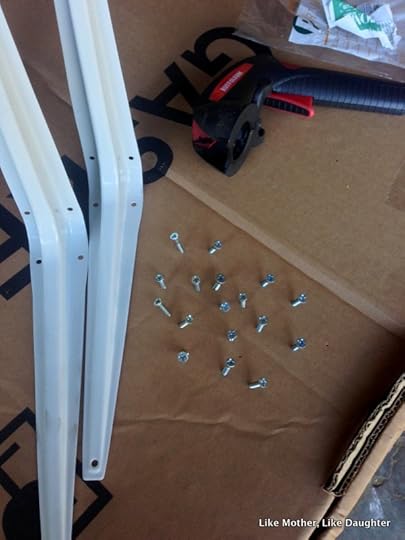
I did not end up using that excellent nozzle, which saves your hand for many types of cans. The one I chose happened to have the kind of cap that won’t accept the trigger thingie.

(The jury is still out on the actual color. We shall see. It looks astonishingly lurid here and maybe also in real life.)

You can see that as I neared the end of the project, I took the screws away so that the threads wouldn’t get gummed up with paint. The cardboard testifies to my sweeping motion. I didn’t spray at each bracket — I just went back and forth. I turned the whole cardboard to get different angles. That glare is in real life, because spray paint is (usually) shiny. Make sure you examine the object from all angles.
With regular painting, you do a coat and then you do a second one. With spray painting, you do multiple coats, all quite light.
Use a mask (I didn’t, even though I have masks, but I did hold my breath. I figure that it’s a good way to prevent myself from over-spraying at any point). And don’t wear flip-flops. The spray is in the air. It settles down and you end up with lightly coated feet. Trust me.
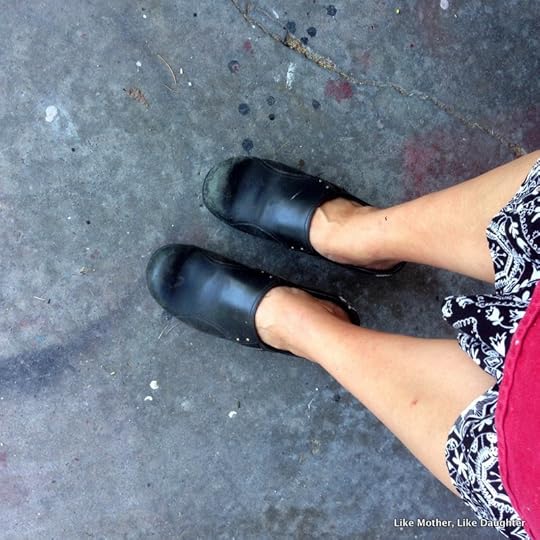
I rarely sand.
I don’t prime.
If there is a drip, wipe it away, let it dry, see if it needs to be sanded a little. Re-coat.
It’s alkyd (non-latex) paint, so it’s durable.
I think that is all — I can answer any questions in the comments. It’s really easy to spray paint stuff! I have lots of things here that I’ve spray painted over the years — I really recommend it!
The post A little spray-paint tutorial, in which my methods are revealed. appeared first on Like Mother Like Daughter.
August 27, 2016
{bits & pieces}
The weekly “little of this, little of that” feature here at Like Mother, Like Daughter!

Dear Anel asked me about my spray-painting setup in a comment. I hope to have a post for you next week as I work on our laundry room shelves. The highly professional way I do this will blow. your. mind.
On to our links!
Getting angsty about homeschooling? Don’t miss my post from the other day, As a New School Year Begins, Some Thoughts. And if you are really spiraling out of the sanity zone, worrying about writing, be sure to click on the links at the end on writing. Furthermore, listen. If you want your child to learn to write a good essay, take a little break from cracking him on the head with essay-writing formulae and read a good essay together. Really read it. Enjoy it, especially how satisfyingly it ends. Appreciate how it’s more than five paragraphs. See if you agree with it. Try this one: You’re probably misreading Robert Frost’s most famous poem. (Frost is a great poet. Be sure you read the poem and talk about it a bit first.)
Take a look at this Ambleside list of essays. Be sure to include interesting and delightful essays in your older child’s reading — whether said child is homeschooling or not. How will children learn to write? By having something to say (not right away!) and by having good models. The “essay-writing method” approach is not often fruitful to spend a lot of time on.
We’ve posted about Lizz Lovett’s selfless, life-affirming journey towards death before. Here is a final chapter, very beautiful: After Death: A husband’s final act of love for his wife. Do you have resources for caring for one’s dead that you recommend?
A good interview on sacred music with Wyoming Catholic College’s Peter Kwasniewski: Human Beings Need Beautiful Things. Keep reading about sacred music and you will get it.

If you are anywhere in the greater Boston area, please come to this Mass for the Feast of St. Gregory on September 2! It is going to be amazing, with a rarely heard Palestrina Mass and the beautiful Ordinariate liturgy. This year it will be their newly ordained Bishop Lopes who will be celebrating. Note that the Mass will be at St. Andrew’s Parish in North Billerica, Massachusetts (not their usual venue).
Sexuality and Gender: A Must-Read on the science and, of course, the ontology. This thorough look at the research done on the subject of homosexuality and “transgender” is under heavy criticism — but with no actual content to the detraction. Read for yourself.
It’s a thing: Knitting while watching, or Knitflix. What do you watch while you knit?
Watch a tuba being made (audio not necessary — they should have played tuba music!):
Baseballically speaking (that’s a phrase I once heard Ted Williams utter in an interview; sadly, the Chief was out of the room and had to take my word for it!):
Red Sox rookie Andrew Benintendi committing highway robbery:
VIDEO: Andrew Benintendi may have just made the catch of the season https://t.co/vKLc7ASt0J pic.twitter.com/ZlmRTLfasn
— Deadspin (@Deadspin) August 23, 2016
Mookie Betts, “I can make a great play too.”
.@mookiebetts shows off the cannon!https://t.co/oGwKlGOl8J
— Boston Red Sox (@RedSox) August 24, 2016
Enjoy your weekend!
St. Monica, pray for us and our children!
From the archives:
As school begins, dinner together is even more important than ever.
From Deirdre: Is it scary to form a St. Gregory Pocket? (Also, send us a picture!)
~We’d like to be clear that, when we direct you to a site via one of our links, we’re not necessarily endorsing the whole site, but rather just referring you to the individual post in question (unless we state otherwise).~
Follow us on Twitter.
Like us on Facebook.
Auntie Leila’s Pinterest.
Rosie’s Pinterest.
Sukie’s Pinterest.
Deirdre’s Pinterest.
Habou’s Pinterest.
Bridget’s Pinterest.
Auntie Leila’s Ravelry.
Auntie Leila’s Instagram.
Rosie’s Instagram.
Sukie’s Instagram.
Bridget’s Instagram.
The post {bits & pieces} appeared first on Like Mother Like Daughter.

